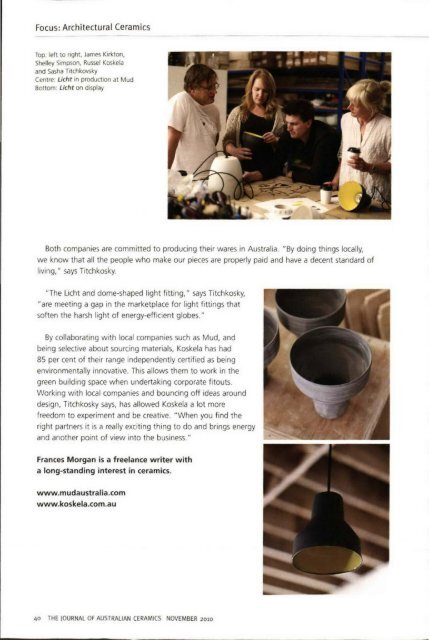The Journal of Australian Ceramics Vol 49 No 3 November 2010
You also want an ePaper? Increase the reach of your titles
YUMPU automatically turns print PDFs into web optimized ePapers that Google loves.
Focus : Architectural <strong>Ceramics</strong><br />
Mud + Koskela = Licht<br />
Frances Morgan discusses a switched-on collaboration<br />
A collaboration between furniture design company Koskela® and ceramic homeware design outfit<br />
Mud" Australia, has led to the production <strong>of</strong> two light fittings that have been installed in corporate fit<br />
outs and are selling in the United States and Europe.<br />
<strong>The</strong> idea for the collaboration came about when Sasha Titchkosky and Russel Koskela, <strong>of</strong> Koskela,<br />
designed a light shade to s<strong>of</strong>ten the harsh glow emitted from energy-saving globes. <strong>The</strong>y approached<br />
Shelley Simpson and James Kirkton from Mud to produce the design, which is called Licht. "We took<br />
the concept to them because we liked the way they deal with ceramics, the vibrancy <strong>of</strong> their colour and<br />
the finishes they do," says Titchkosky.<br />
For Simpson, who started Mud in 1994, it was an opportunity to venture in a direction she had<br />
always wanted to go. "Lighting for me is something that I've been interested in but never had the time<br />
to properly resolve." Koskela has been producing lighting for over eight years (most recently developing<br />
light fittings with weavers from Elcho Island in Arnhem Land) so had worked out many <strong>of</strong> the intricacies<br />
around quality componentry and cabling. "<strong>No</strong>w that we have the joint skills <strong>of</strong> this partnership j'm<br />
looking forward to bringing other designs to life," says Simpson.<br />
Mud also had a dome shape that they wanted to produce. <strong>The</strong> dome design had actually started<br />
its life as a rubbish bin when, some years ago, Mud collaborated with a company in the United States<br />
called Waterworks, to produce a bathroom rang e. " I think people felt uncomfortable about placing<br />
porcelain on the floor," says Simpson. However, she liked the design and held onto the idea. When the<br />
collaboration with Koskela came about she revisited the bin design and with some minor adjustments,<br />
flipped it over to form the design for a light shade.<br />
"Licht, like most <strong>of</strong> Koskela 's wares, has a Scandinavian inspired aesthetic," says Titchkosky. "<strong>The</strong><br />
flared outer rim was especially created to allow people to see up into the light."<br />
Both Licht and the dome fitting are made <strong>of</strong> Limoge porcelain, which Mud uses for all their wares.<br />
Colour is introduced by tinting the porcelain slip slate, canary yellow or white. <strong>The</strong>y are also produced<br />
in spliced combinations <strong>of</strong> colour - for instance slate on the outside surface and yellow on the inside -<br />
created by repouring the contrasting colour <strong>of</strong> slip into the mould.<br />
Vitrified porcela in on the outer surface feels like rough parchment, while the inside is glazed so it<br />
reflects the light <strong>The</strong> plain white light when lit appears translucent and emits a pale orange hue from<br />
the globe.<br />
Collaborating with Koskela felt right to Simpson. Koskela is a similar-sized company also being run<br />
by a husband-and-wife team, and while Mud has made attempts in the past to collaborate with large<br />
companies with little result, working with a similar-sized company with a similar ethos felt more even .<br />
38 THE JOURNAL OF AUSTRALIAN CERAMICS NOVEMBER <strong>2010</strong>


















